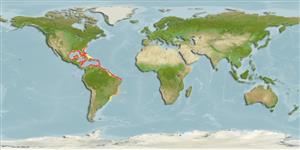Environment: milieu / climate zone / depth range / distribution range
Ecología
marino asociado a arrecife; rango de profundidad 25 - 550 m (Ref. 5217). Tropical
Western Atlantic: South Carolina, USA and northern Gulf of Mexico to the Guianas. Unknown from the West Indies except off western Bahamas and Cuba. Also eastern Gulf of Mexico and western Caribbean (Ref. 26938).
Tamaño / Peso / Age
Maturity: Lm ? range ? - ? cm
Max length : 45.0 cm TL macho / no sexado; (Ref. 7251); common length : 30.0 cm TL macho / no sexado; (Ref. 5217); peso máximo publicado: 500.00 g (Ref. 5217)
Espinas dorsales (total): 0; Radios blandos dorsales (total): 11-12; Espinas anales 0; Radios blandos anales: 10 - 11. Inner rays of pelvic about equal to or shorter than outer rays (Ref. 13608).
Found on sand or mud bottoms.
Life cycle and mating behavior
Madurez | Reproducción | Puesta | Huevos | Fecundidad | Larva
Robins, C.R. and G.C. Ray, 1986. A field guide to Atlantic coast fishes of North America. Houghton Mifflin Company, Boston, U.S.A. 354 p. (Ref. 7251)
IUCN Red List Status (Ref. 130435)
Threat to humans
Harmless
Human uses
Más información
Nombres comunesSinónimosMetabolismoDespredadoresEcotoxicologíaReproducciónMadurezPuestaAgregación para la puestaFecundidadHuevosEgg development
ReferenciasAcuiculturaPerfil de acuiculturaRazasGenéticaElectrophoresesheritabilidadEnfermedadesProcesamientoNutrientsMass conversion
ColaboradoresImágenesStamps, Coins Misc.SonidosCiguateraVelocidadTipo de nataciónSuperficie branquialOtolitosCerebrosVisión
Herramientas
Special reports
Download XML
Fuentes de Internet
Estimates based on models
Preferred temperature (Ref.
123201): 13.8 - 24.4, mean 19.1 °C (based on 154 cells).
Phylogenetic diversity index (Ref.
82804): PD
50 = 0.5000 [Uniqueness, from 0.5 = low to 2.0 = high].
Bayesian length-weight: a=0.00501 (0.00236 - 0.01065), b=3.10 (2.93 - 3.27), in cm total length, based on LWR estimates for this Genus-body shape (Ref.
93245).
Nivel trófico (Ref.
69278): 4.3 ±0.7 se; based on diet studies.
Resiliencia (Ref.
120179): Medio, población duplicada en un tiempo mínimo de 1.4-4.4 años (Preliminary K or Fecundity.).
Fishing Vulnerability (Ref.
59153): Low to moderate vulnerability (35 of 100).
Nutrients (Ref.
124155): Calcium = 36.8 [13.2, 77.1] mg/100g; Iron = 0.455 [0.161, 1.022] mg/100g; Protein = 15.3 [12.8, 17.7] %; Omega3 = 0.0734 [, ] g/100g; Selenium = 54.7 [21.3, 121.3] μg/100g; VitaminA = 87.5 [22.9, 296.0] μg/100g; Zinc = 0.772 [0.446, 1.163] mg/100g (wet weight);
